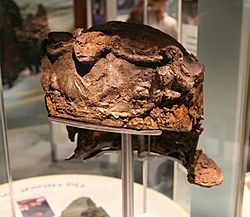Hallaton Helmet facts for kids
Quick facts for kids Hallaton Helmet |
|
|---|---|

The Hallaton Helmet
|
|
| Material | Iron |
| Size | 407 millimetres (16.0 in) high |
| Created | Roman, 1st century AD |
| Discovered | By amateur archaeologists in 2000 |
| Place | Hallaton, Leicestershire |
| Present location | Harborough Museum |
The Hallaton Helmet is a very special Roman helmet. It was used by cavalry, who were soldiers who fought on horseback. This helmet was made of iron and covered with shiny silver. It even had gold decorations!
It was found in 2000 near Hallaton, Leicestershire, in England. An amateur archaeologist named Ken Wallace first found some old coins there. Later, professional archaeologists from the University of Leicester found that the area was once a large Iron Age shrine.
The helmet was broken into many pieces and was very rusty. Experts at the British Museum spent nine years carefully putting it back together. They got help from a grant of £650,000 from the Heritage Lottery Fund. Today, you can see the Hallaton Helmet at the Harborough Museum in Market Harborough. It is displayed with other amazing items from the Hallaton Treasure hoard.
Even though it was found in tiny pieces, the helmet still shows its beautiful original design. It was covered in silver and gold. It also had pictures of goddesses and horses. A Roman cavalryman would have worn it for parades and maybe even in battle. We don't know who owned it. But it was found at an ancient British site, buried with thousands of British and Roman coins. Perhaps a Briton who fought with the Romans owned this amazing helmet.
How the Hallaton Helmet Was Found
The helmet was discovered by Ken Wallace, who was 71 years old at the time. He was a retired teacher and loved looking for old things. In 2000, he and other members of the Hallaton Fieldwork Group found pieces of Roman pottery on a hill near Hallaton.
One afternoon, Ken went back to the site with a metal detector. He found about 200 coins buried in small holes in the clay. He also found another object, but he left it in the ground overnight. The next day, he went back and saw it was a silver ear!
He told the county archaeologist in Leicestershire about his find. The University of Leicester Archaeological Services (ULAS) then came to dig up the site. The main excavation happened in the spring of 2003.
Putting the Helmet Back Together
The helmet was too fragile to be dug up on the spot. So, the archaeologists removed it in a block of earth. This block was held together with plaster of Paris. It was then taken to the British Museum in London for conservation.
It took nine years for experts like Marilyn Hockey and her team to restore it. The helmet had broken into thousands of tiny pieces over time. Most of these pieces were smaller than a fingernail! The reconstructed helmet was finally shown to the public in January 2012.
Leicester County Council raised £1 million to buy the entire treasure hoard. This money also paid for the helmet's restoration. The Heritage Lottery Fund gave a large grant of £650,000. Other groups like the Art Fund also helped.
The helmet itself was valued at £300,000. According to the Treasure Act, Ken Wallace and the landowner each received £150,000.
At the end of January 2012, the helmet went on permanent display. You can see it at the Harborough Museum in Market Harborough. This museum is only nine miles from where the treasure was found.


